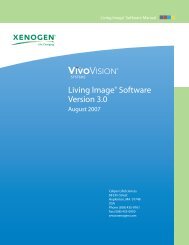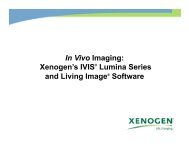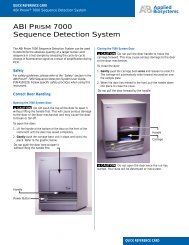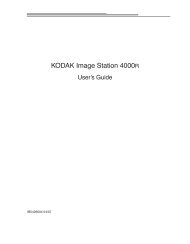ABI PRISM 7000 Sequence Detection Systems Relative ...
ABI PRISM 7000 Sequence Detection Systems Relative ...
ABI PRISM 7000 Sequence Detection Systems Relative ...
Create successful ePaper yourself
Turn your PDF publications into a flip-book with our unique Google optimized e-Paper software.
Introduction<br />
1<br />
About the <strong>7000</strong> SDS Instrument<br />
Description<br />
The <strong>ABI</strong> <strong>PRISM</strong> ® <strong>7000</strong> <strong>Sequence</strong> <strong>Detection</strong> System (<strong>7000</strong> SDS instrument) is a secondgeneration<br />
sequence detection instrument capable of quantitative and qualitative<br />
detection with fluorescent-based PCR chemistries. The instrument is capable of<br />
quantitative detection using real-time analysis, and qualitative detection using end-point<br />
and dissociation-curve analysis.<br />
The <strong>7000</strong> SDS instrument combines thermal cycling, fluorescence detection, and<br />
application-specific software. It detects accumulated polymerase chain reaction (PCR)<br />
product cycle-by-cycle, thus making quantification available immediately after<br />
completion of PCR, without the need for further process analysis.<br />
Supported Assay<br />
Types<br />
The <strong>7000</strong> SDS instrument allows you to perform the following assays with plates or<br />
tubes in the 96-well format:<br />
• <strong>Relative</strong> Quantification (RQ) – Determines the quantity of a single nucleic acid<br />
target sequence within an unknown sample, relative to the same sequence within a<br />
calibrator sample<br />
• Absolute Quantification (AQ) – Determines the absolute quantity of a single<br />
nucleic acid target sequence within a sample<br />
• Allelic Discrimination (AD) – Indicates the genotype of samples.<br />
• Plus/Minus – Indicates the presence or absence of a specific target sequence in a<br />
sample<br />
DRAFT<br />
September 26, 2003 3:14 pm, C1_Intro.fm<br />
For more information about the assay types, refer to the <strong>Sequence</strong> <strong>Detection</strong> <strong>Systems</strong><br />
Chemistry Guide and the Online Help for the <strong>7000</strong> SDS instrument.<br />
About <strong>Relative</strong> Quantification<br />
Real-time PCR<br />
Assays<br />
Real-time PCR is the ability to monitor the progress of the PCR as it occurs. Data is<br />
collected throughout the PCR process rather than at the end of the PCR process<br />
(end-point PCR).<br />
In real-time PCR, reactions are characterized by the point in time during cycling when<br />
amplification of a target is first detected rather than the amount of target accumulated at<br />
the end of PCR.<br />
There are two types of quantitative real-time PCR: absolute and relative.<br />
Notes<br />
<strong>Relative</strong> Quantification Getting Started Guide for <strong>7000</strong> v1.1 1










